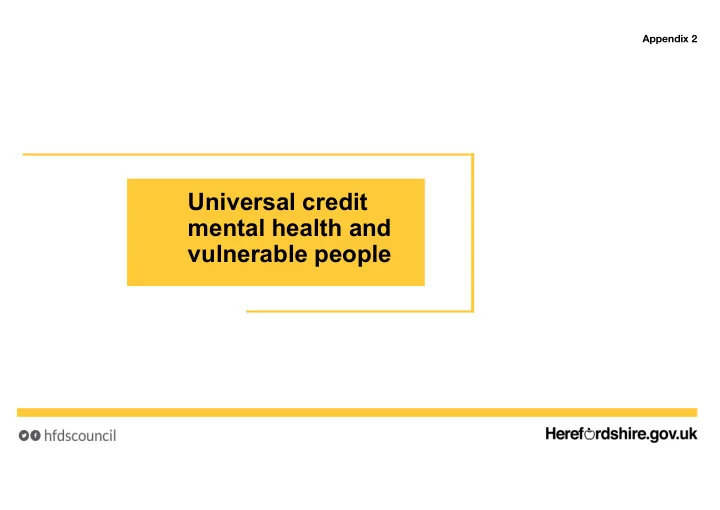

Appendix 2 Universal credit mental health and vulnerable people
Universal credit and welfare benefit changes UC replaces 6 benefits including housing benefit. (JSA, IS, ESA, WTC, CTC and HB) 1 organisation dealing with claim in place of 3 (DWP, HMRC and Local Authority Revs and Bens) • Intention is to ensure people are better off in work. • Intention it ‘mirrors work’: paid monthly/ 5 weekly in arrears, paid directly to claimant household BUT low paid often paid weekly • Part time and short term work as stepping stone into permanent employment. Full service in Herefordshire from 13 th June 2018 – digital, personalised service For housing providers a number of risks: • Housing element of UC is last to be paid • 5 week delay in payment • Payment direct to tenant • If household reaches £20, 000 benefit cap some or all of UC(HE) not paid. Risk averse landlords mitigate by: • Refusal to take benefit claimants • Affordability assessments by RPs • Rent up front: some requiring up to 4 weeks even though weekly tenancies—affecting access to social rented properties. DWP mitigation: Alternative payment arrangements Advance payments April 2019 fund CAB to provide Universal Support – helps claimant to make and maintain a claim but l imited CAB service in Herefordshire.
SPARE ROOM SUBSIDY OR THE BEDROOM TAX 14% reduction in HB/UC (HE) for 1 bed under-occupied. 25% reduction for 2 bed under-occupied. Moving to private rented doesn’t necessarily reduce cost to HB. Number of smaller units insufficient to enable all affected tenants to downsize. DHP has provided support for affected tenants but is not guaranteed over time. LOCAL HOUSING ALLOWANCE Remained at same level since April and will remain so to April 2020. Based on 30 th percentile but increasingly fewer properties available which are affordable to benefit recipients. Access to private rented sector limited and claimants can’t sustain tenancy as rent rises. Rent in the private rented sector in much of the country have increased faster than wage growth. private rented properties becoming less affordable, which in turn is likely to be contributing to homelessness caused by the ending of an assured shorthold tenancy
Discretionary Housing Payment policy DHP: the council has the power to award additional help with housing costs to people in receipt of HB or the housing element of universal credit and receives central government funding: c.£295K 2018/19. Previous years DHP underspent so: Jan 2018 : DHP policy amended to align to strategic housing priorities, including prevention of homelessness. Objectives include to: • Alleviate poverty • Sustain tenancies and prevent homelessness • Support the vulnerable or elderly • Support those leaving care • Support those being discharged from detention • Support those affected by welfare reforms including : o Bedroom under occupancy o The benefit cap o Reductions in local housing allowance • Assist with ‘one off’ lump sum housing costs including rent deposits, rent in advance and help with removal costs
Mental Health Poor mental health is a 2 way street. People with poor mental health are more susceptible to main factors that can lead to homelessness: Poverty – often lack capacity to sustain employment, so have little income Disaffiliation – withdrawal from friends, family & loss of support = fewer coping resources. Personal vulnerability – mental ill health impairs resilience, clouds thinking and judgement. So, people with mental illness are at greater risk of experiencing homelessness but homelessness amplifies poor mental health by exacerbating anxiety, fear, depression, sleeplessness and potentially substance use. 77% of homelessness people in England report mental health issues: 45% diagnosed with a mental condition. (Homelessness Link 2011/14). Herefordshire’s draft Homeless Health Needs report shows 75% locally reported mental health issues.
Homeless children are three to four times more likely to have mental health problems than other children. (Shelter, 2006) Needs of homeless with mental poor mental health are similar to those without it: physical safety, education, transportation, affordable housing, and affordable medical/dental treatment. Current specialist targeted provision for homeless with mental health needs: Accommodation based support – 30 units including but not limited to people with mental health needs , potentially increasing to 35 units in 12 months Floating support – up to 75 clients including but not limited to people with MH needs Targeted provision in development pipeline: • 8 units for vulnerable people aimed at those with mental health issues in early stages of development. Access will be through direct nomination by ASC team. Anticipated completion date – 2020/1 • Additional 6 units in Hereford city earmarked for people with mental health issues. Access will be through direct nomination by ASC team. Anticipated completion date –2021/2
Vulnerable groups Vulnerable may include rough sleepers, young people, ex-offenders, former armed forces personnel and/or family members, people with substance dependencies or mental health issues, people with challenging behaviours and socially marginalised, pensioners, people experiencing domestic abuse, pregnant women and families. But you are not automatically classed as vulnerable under homelessness legislation if you fit into one of these groups. Review of models and need/trend data plus outcome evidence to include temporary accommodation, short term supported housing and tenancy support. Strategy is to bring into use more accommodation for vulnerable groups, using a three-phased approach: i. Utilising existing accommodation and ensuring its best use in accordance with identified need. ii. Securing new accommodation relatively quickly through open market purchase or re-negotiation for specialist provision in upcoming developments. iii. Negotiated specialist accommodation through new-build development Current specialist targeted provision for vulnerable homeless includes : Women's refuge- 9 units Foyers for young people – 30 bed spaces Newly negotiated agreement with registered provider due to commence Christmas 2018: Ex-offenders – up to 10 units Targeted provision in development pipeline: 6-8 units for young people with complex needs. Nominations from CWB/ASC. Anticipated completion 2020/1 6-8 units for ex-offenders. Nominations from probation/CRC. Anticipated completion 2020/1 This approach will run alongside the development of coherent, deliverable models of housing management and care and support.
Recommend
More recommend